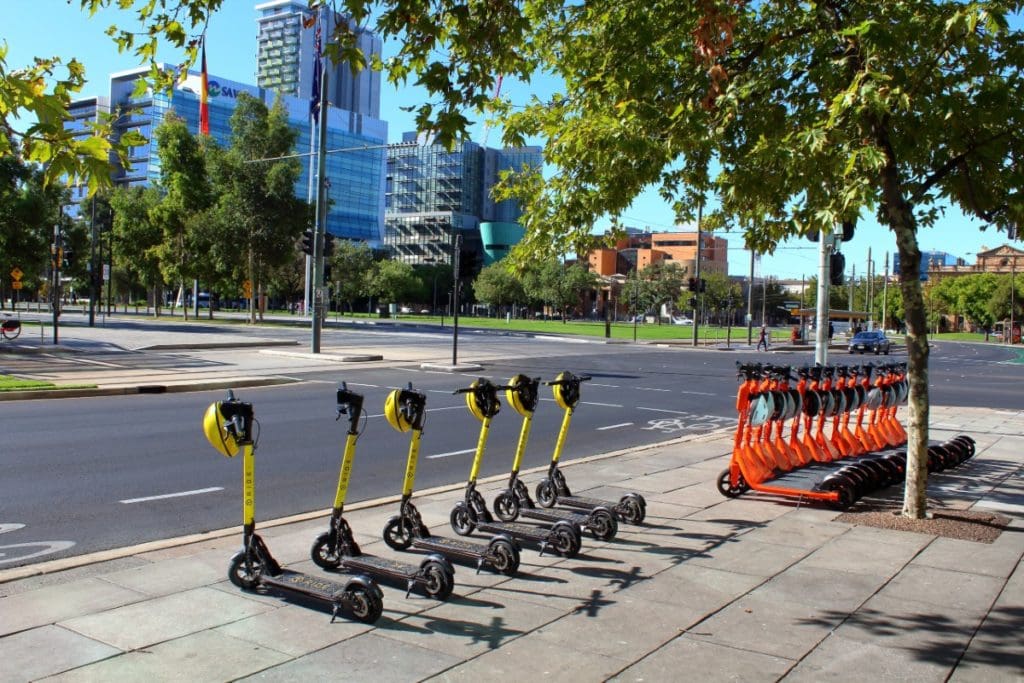An Insider’s Perspective of Australia’s E-Scooter Share Schemes

Brisbane / Queensland
By Dan Barr, Director of Better Cities Group*
Colourful e-scooters on footpaths, in parks and at bus stops, have become common place in several Australian cities in a very short time. They range in colour from green, orange, purple and yellow, depending on the operator.
Periodically, cities have changed colours, authorising different operators to host e-scooter hire schemes in their city. The dominant operators in Australia are currently Beam (purple), Neuron Mobility (orange) and Lime (green).
Since Lime initiated Australian services in Brisbane in late 2018, with over 50,000 rides being taken in the first two weeks, other cities have been quick to follow. In just over two years, e-scooter hire schemes have been approved in Adelaide, Brisbane, Darwin, Charles Sturt (north-western Adelaide), Port Adelaide, Townsville, West Torrens (western Adelaide), Canberra and Bunbury.
Overcoming Safety Concerns
The roll out in Brisbane in 2018 and early 2019 led to significant media coverage regarding accidents involving riders and community members. This led to significant investment by e-scooter hire companies in relation to helmet use and safety training for riders.
To increase helmet use, technical advancements using artificial intelligence to recognise that a rider is wearing a helmet has been coupled with commercial incentives such as reduced fees for doing the right thing.
This has also been applied to rider behaviour where geolocating technology is able to slow down riders going too fast in defined locations or riding erratically.
In Brisbane City Council’s draft e-mobility strategy (Brisbane’s draft e-mobility strategy (2020)) it notes that, ‘A study on micro-mobility published by the Organisation for Economic Co-operation and Development (OECD) concluded that the risk of an emergency department visit for an e-scooter rider is similar to that for cyclists’. (OECD/ITF (2020) Safe Micromobility, ITF Corporate Partnership Board.) This highlights the significant change in mindset regarding the safety of e-scooter use.
Technical Innovation
As Australian cities have adopted e-scooter hire schemes, they have become increasingly interested in technical innovation related to the hardware (the e-scooter) and the software (app and operations centre support).
This has led to continued innovation of e-scooters with larger wheels, swappable batteries and geolocation all expected in the latest generation scooters.
Innovations such as the app-controlled helmet lock and topple detection have mitigated initial community frustrations regarding lost helmets and scooters lying across footpaths.

Ebike Integration
In the past few months, we have seen cities like Darwin, Charles Sturt and Brisbane look to integrate ebike here schemes into their existing e-scooter hire programs – effectively seeking an integrated e-mobility program. Other cities like the Gold Coast and Bondi in Sydney have initiated ebike hire schemes in isolation.
The integration of ebikes provides a greater range of travel and effectively offers e-mobility opportunity to larger parts of the community. For a radial city with a defined CBD this provides the potential for not just the CBD to choose e-mobility, but large areas of suburbia as well.
Cities Are Benefitting
E-mobility adoption is increasingly being seen as an important tool to provide a greater variety of transport choice to residents and visitors.
As Australian cities look to reduce private vehicle use, increase public transport patronage and grow active travel uptake, e-mobility is becoming an important part of the bigger picture in reducing congestion and operating healthier cities.
Many of the initial difficulties of e-mobility such as clutter in the public realm and poor rider behaviour are being better managed, which has enabled the many benefits of e-mobility to be seen in a more favourable light.
As COVID-19 shocked many cities and their local traders, a number of e-scooter hire providers developed strong connections between its riders and local businesses. This took the form of reduced fees for buying local and in-app marketing of local businesses such as cafes and restaurants. This generated goodwill at a local and political level whilst also demonstrating the powerful economic development potential of e-mobility.
E-mobility is also increasingly being seen as a mode of transport that enables residents to not need to make the significant investment in a private motor vehicle. In addition to affordability, it presents the opportunity for people of varying ages and abilities to include active travel in how they move around their city.
What Will Happen Next?
Considering the significant impact that e-mobility hire schemes have had on Australian cities in just two years, it is safe to assume that there will be continued innovation and advancement in the sector over the next two years.
Some of the trends to watch for include:
- Many new local governments seeking integrated e-mobility (e-scooters and ebike) hire schemes.
- Significant innovation in e-scooter design with a push to three wheels and e-scooters that are automated and can be remotely removed (for number rebalancing and safety reasons), and to provide an on-demand service for riders (where the scooter comes to the rider).
- Greater integration into other transport services (mobility as a service) to enable better outcomes for riders transitioning from e-mobility to public transport or vice versa.
- Increased city investment in dedicated parking locations (eg. public transport nodes, city centres) and delineated travel lanes.
Join the Conversation: Let us know your thoughts about what you think will happen next? Please comment below.

* Authors Stephen Coulter and Krystyna Weston are the founders of Zipidi Micromobility and Convenors of the Asia Pacific Micromobility Alliance
